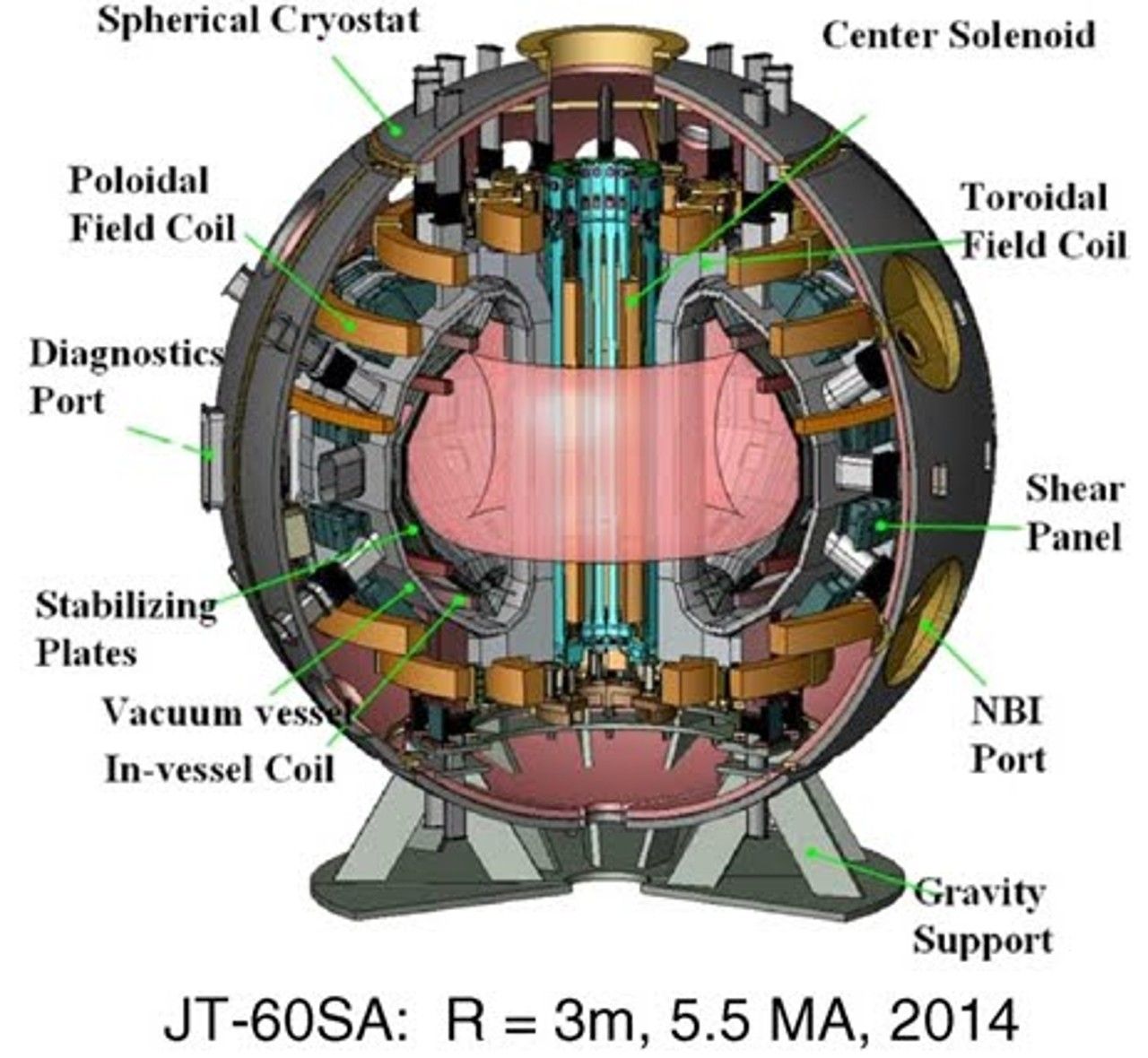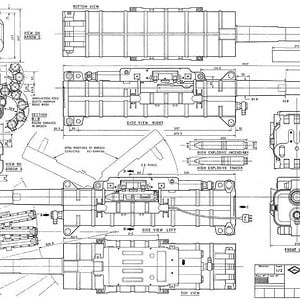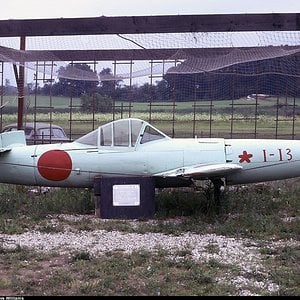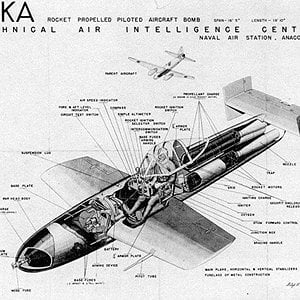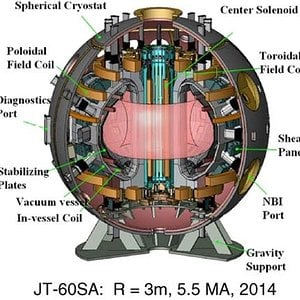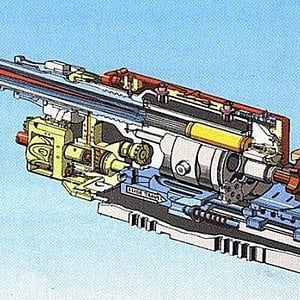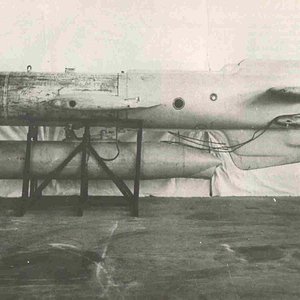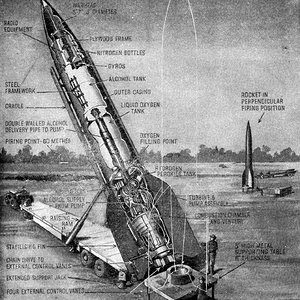Navigation
Install the app
How to install the app on iOS
Follow along with the video below to see how to install our site as a web app on your home screen.
Note: This feature may not be available in some browsers.
More options
You are using an out of date browser. It may not display this or other websites correctly.
You should upgrade or use an alternative browser.
You should upgrade or use an alternative browser.
The Nazi weapons appeared to utilise Uranium 233 harvested from particle accelerators as Protactinium 233. This device is often referred to as the Nazi Bell. It was a device developed under Dr Walter Dallenbach by the German Army Ordnance research team Forschungstelle D. Several such synchrotron type centrifuges were built by the Berlin firm BAMAG Meguin, under contract to C.H. Muller, at Dessau where Junkers also built aircraft engines.
Special flights by Junkers Ju-290 aircraft carrying crates of aircraft engines are said to have occurred during 1944, flown by aircraft with civilian pilots and Deutsch Luft Hansa markings. Could these cargoes in fact have been carried duplicates of the Nazi particle accelerator, or plans for one’s construction?
Albert Speer in his memoirs wrote of a Ju-390 flight from Bardufoss Norway to Tokyo via the “Polar Route” in 1945, flown by civilian test pilots. Two wartime test pilots who flew the giant Junkers Ju-390 also referred after the war to the Ju-390′s Polar flight to Japan.[18]
Conventional cyclotrons are extremely heavy equipment and unsuited to long range flights because of the extreme weight of their magnets. The German particle accelerator device for production of Uranium 233 described by Dr Rolf Wideroe however appears from descriptions to have been lighter than a conventional Cyclotron and more like a centrifugal synchrotron.
Successful testing of Japan’s A-bomb?
An article appeared in World War II Magazine (July 1995) by Al Hemingway that indicates indeed, that Japan may have exploded an atomic bomb on a tiny islet in the Sea of Japan on August 12, 1945. Hemmingway refers to a test also involving a cave.
David Snell reported that Kempetai Captain Tsetusuo Wakabayashi told him the test occured just after Hiroshima was bombed. Wilcox gives an account from Snell that on 10 August 1945 an Atomic bomb was removed from a cave above Konan, transported to a robot launch. It is reported that at dawn 12 August 1945 the launch carrying the A-bomb device called Genzai Bakudanbeached itself on a tiny island in the sea of Japan. The location of these islets is north of Wonsan in the Gulf of Yonghung-Man. Unfortunately the name of the individual island where the test occurred is not recorded.
It is known that a Japanese plan for an Atomic Bomb was drawn up in July 1943 and came into possession of the OSS. These plans were rediscovered in 2002 and were returned to Japan where the Japanese government now controls them. [19] A US Army surgeon based in Japan in 1947 with the 237th Medical Disp. to examine after effects of Atomic Bombs on the victims, Leon Thompson wrote to the Millitary Magazine on 9 November 1996, claiming to have seen the Japanese bomb’s blueprint in the OSS offices at Tokyo. At this time OSS was known as the SSU and was about to become the CIA.
Radio operator of U-234 Wolfgang Hirschfeld also wrote in an account for the website Sharkhunters, in which he caimed that Japan had alreadysuccessfully tested an atomic bomb in 1943. Conceivably Hirschfeld may be wrong that there was a test in 1943, but it is also interesting to note he was somehow informed about Japan’s nuclear project before leaving Germany implying some degree of co-operation between these countries during the War years.
Capt. Wakabayashi asserted to Snell that bomb laboratories hidden in caves above Konan along with a number of completed Atomic weapons were demolished to prevent their capture. Soviet paratroops captured the city unexpectedly on 24 August 1945 whilst fighting was occurring much further north along Korea’s coast. This sudden attack led to the capture of six key scientists responsible for F-NZ.
A chemical engineer in the F-NZ project Otogoro Natsume agreed to work for his Soviets captors and in October 1946 used the trust gained to steal a small fishing boat and escape to American forces further south. Natsume was interrogated through an interpreter by the Americans. He had also heard of the nuclear test whilst at Konan before the Soviets arrived.
Natsume revealed that decomposition of Hydrogen Peroxide was part of the process involved in construction of the Atomic weapon implying that it had a thermonuclear aspect. He revealed that there were 700 university graduates working at two Factories for F-NZ. Three hundred of these graduates worked at Konan. One factory was at Konan, the other at Honbu.
Natsume said Soviets arrived so quickly that they captured seven key scientists. Russians tortured the scientists by thrusting burning slivers under their fingertips and pouring water into their noses. One scientist managed to escape to the American zone but the others he learned were taken back to Moscow where they were tortured further for their secrets.[20]
Japan’s intended use of the Atomic Bomb
Japan’s biggest problem in 1945 was delivery systems. Twelve V-2 rockets had been imported by U-boat before the collapse of Nazi Germany.[21] The correct beach in Kyushu had been identified for the intended Allied invasion in 1946. It seems conceivable that underground lunch silos would have been prepared to fire these V-2 rockets at the Allied beach head and the fleet offshore. Had these been nuclear tipped an invasion of Japan could have been carnage.
Bomber missions to mainland USA were a goal but as the war dragged into it’s closing sequences this became less important. Japan was slow to grasp strategic bombing. The distances involved were immense. Honshu Island to Los Angeles was 4,720 nautical miles one way. Seattle was approximately 4,100nm. On the outbound trip a heavily laden bomber would have to climb to 30,000 feet to hitch a ride on Jetstreams and take advantage of higher ground speeds at altitude. The return journey however was against prevailing winds. The shortest possible route was from Paramushiro in the northern Kuril Group. During WW2 the island had four air bases, most with 4,000 ft runways. Had these heavily laden aircraft been able to take off from such runways then the distance to attack Seattle was an acceptable 3,040nm.
It is rumored amongst Nazi veterans that the third Ju-390 prototype was not destroyed but rather completed and flown to Japan. The claim is completely unverifiable, but possible and such an aircraft would have permitted raids on cities along the western USA seaboard. Such an aircraft would have looked something like this:
Special flights by Junkers Ju-290 aircraft carrying crates of aircraft engines are said to have occurred during 1944, flown by aircraft with civilian pilots and Deutsch Luft Hansa markings. Could these cargoes in fact have been carried duplicates of the Nazi particle accelerator, or plans for one’s construction?
Albert Speer in his memoirs wrote of a Ju-390 flight from Bardufoss Norway to Tokyo via the “Polar Route” in 1945, flown by civilian test pilots. Two wartime test pilots who flew the giant Junkers Ju-390 also referred after the war to the Ju-390′s Polar flight to Japan.[18]
Conventional cyclotrons are extremely heavy equipment and unsuited to long range flights because of the extreme weight of their magnets. The German particle accelerator device for production of Uranium 233 described by Dr Rolf Wideroe however appears from descriptions to have been lighter than a conventional Cyclotron and more like a centrifugal synchrotron.
Successful testing of Japan’s A-bomb?
An article appeared in World War II Magazine (July 1995) by Al Hemingway that indicates indeed, that Japan may have exploded an atomic bomb on a tiny islet in the Sea of Japan on August 12, 1945. Hemmingway refers to a test also involving a cave.
David Snell reported that Kempetai Captain Tsetusuo Wakabayashi told him the test occured just after Hiroshima was bombed. Wilcox gives an account from Snell that on 10 August 1945 an Atomic bomb was removed from a cave above Konan, transported to a robot launch. It is reported that at dawn 12 August 1945 the launch carrying the A-bomb device called Genzai Bakudanbeached itself on a tiny island in the sea of Japan. The location of these islets is north of Wonsan in the Gulf of Yonghung-Man. Unfortunately the name of the individual island where the test occurred is not recorded.
It is known that a Japanese plan for an Atomic Bomb was drawn up in July 1943 and came into possession of the OSS. These plans were rediscovered in 2002 and were returned to Japan where the Japanese government now controls them. [19] A US Army surgeon based in Japan in 1947 with the 237th Medical Disp. to examine after effects of Atomic Bombs on the victims, Leon Thompson wrote to the Millitary Magazine on 9 November 1996, claiming to have seen the Japanese bomb’s blueprint in the OSS offices at Tokyo. At this time OSS was known as the SSU and was about to become the CIA.
Radio operator of U-234 Wolfgang Hirschfeld also wrote in an account for the website Sharkhunters, in which he caimed that Japan had alreadysuccessfully tested an atomic bomb in 1943. Conceivably Hirschfeld may be wrong that there was a test in 1943, but it is also interesting to note he was somehow informed about Japan’s nuclear project before leaving Germany implying some degree of co-operation between these countries during the War years.
Capt. Wakabayashi asserted to Snell that bomb laboratories hidden in caves above Konan along with a number of completed Atomic weapons were demolished to prevent their capture. Soviet paratroops captured the city unexpectedly on 24 August 1945 whilst fighting was occurring much further north along Korea’s coast. This sudden attack led to the capture of six key scientists responsible for F-NZ.
A chemical engineer in the F-NZ project Otogoro Natsume agreed to work for his Soviets captors and in October 1946 used the trust gained to steal a small fishing boat and escape to American forces further south. Natsume was interrogated through an interpreter by the Americans. He had also heard of the nuclear test whilst at Konan before the Soviets arrived.
Natsume revealed that decomposition of Hydrogen Peroxide was part of the process involved in construction of the Atomic weapon implying that it had a thermonuclear aspect. He revealed that there were 700 university graduates working at two Factories for F-NZ. Three hundred of these graduates worked at Konan. One factory was at Konan, the other at Honbu.
Natsume said Soviets arrived so quickly that they captured seven key scientists. Russians tortured the scientists by thrusting burning slivers under their fingertips and pouring water into their noses. One scientist managed to escape to the American zone but the others he learned were taken back to Moscow where they were tortured further for their secrets.[20]
Japan’s intended use of the Atomic Bomb
Japan’s biggest problem in 1945 was delivery systems. Twelve V-2 rockets had been imported by U-boat before the collapse of Nazi Germany.[21] The correct beach in Kyushu had been identified for the intended Allied invasion in 1946. It seems conceivable that underground lunch silos would have been prepared to fire these V-2 rockets at the Allied beach head and the fleet offshore. Had these been nuclear tipped an invasion of Japan could have been carnage.
Bomber missions to mainland USA were a goal but as the war dragged into it’s closing sequences this became less important. Japan was slow to grasp strategic bombing. The distances involved were immense. Honshu Island to Los Angeles was 4,720 nautical miles one way. Seattle was approximately 4,100nm. On the outbound trip a heavily laden bomber would have to climb to 30,000 feet to hitch a ride on Jetstreams and take advantage of higher ground speeds at altitude. The return journey however was against prevailing winds. The shortest possible route was from Paramushiro in the northern Kuril Group. During WW2 the island had four air bases, most with 4,000 ft runways. Had these heavily laden aircraft been able to take off from such runways then the distance to attack Seattle was an acceptable 3,040nm.
It is rumored amongst Nazi veterans that the third Ju-390 prototype was not destroyed but rather completed and flown to Japan. The claim is completely unverifiable, but possible and such an aircraft would have permitted raids on cities along the western USA seaboard. Such an aircraft would have looked something like this:

